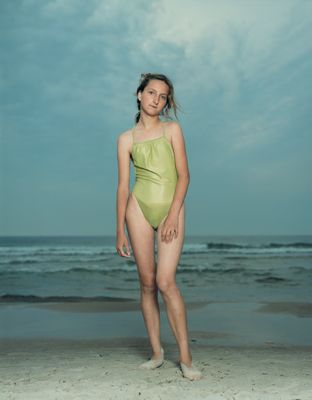
Rineke Dijkstra, “Kolobrzeg, Poland, July 26, 1992”. Source: Guggenheim.org. Courtesy the artist and Marian Goodman Gallery, New York and Paris. © Rineke Dijkstra
There are times when you just have to sit for a while in order to experience an exhibit… and sometimes there are also benches in the picture. I got lucky on steamy summer day and both elements came together for a recent visit to Rineke Dijkstra’s retrospective at the Guggenheim, on view through October 8th.
Any kind of shopping mall mentality will get most visitors nowhere in this show. Sitting in one of the galleries I saw quite a few people pop in and after twenty (solid!) seconds ask, “Kids on the beach?”
Yes. Kids on the beach.
What many visitors missed by running out too soon was revealed to those who may have lingered. Like I said, I got lucky. Rineke Dijkstra’s exquisite retrospective is a chance for anyone who attends to experience in a particular (and sometimes peculiar) way how an exhibition can slowly work on you. I have to admit, I had seen Dijkstra’s work a few times before, but in much smaller settings that contained only a fraction of the photographs. Seeing this show, which will test your sense of direction over several floors, is a chance to really compare first impressions and second thoughts against some smart and simultaneously straightforward wall text. And how often can you say that? The verbal gymnastics provided by some museums and galleries can often be a distraction but this is not one of those instances.
Dijkstra’s series work, particularly in her Beach Portraits, allow these “monumental” photos to actually look back at the viewer over time. Sitting with the work, visitors will notice how similar and yet wildly different these teenagers are. Gestures are juxtaposed with choices of clothing or swimwear that actually facilitate the “conversation” these works have in a room together. The relationship each subject has with the photographer is part of how they are posed without really “posing”. There’s an in-between-poses kind of quality that begins to inform our looking beyond faces and fashion.
Rineke Dijkstra, “Almerisa, Asylum Center Leiden, Leiden, Netherlands, March 14, 1994”. Source: Guggenheim.org. Courtesy the artist and Marian Goodman Gallery, New York and Paris. © Rineke Dijkstra
In another part of the exhibition Dijkstra’s Almerisa series, which began in 1994 with a single photograph of a young Bosnian girl at a Dutch refugee center and has continued for over a decade, literally envelopes the viewer. Eleven large photographs across three walls take visitors through her transformation from a child to an adult to a woman with a child of her own. Dijkstra strips the backgrounds in this series, as she often does, so there isn’t a trace of anything to distract. The rooms are bare. The compositions are uncomplicated. The faces border on emotionless. Here too, you get the opportunity to compare photographs taken at different times and learn not just about the subject and artist, but also about how, for example, these photographs might relate to specific personal memories about growing up or rites of passage.